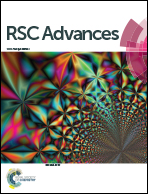A step towards the processability of insoluble or partially soluble functional and structural variants of polymers based on 3,4-alkylenedioxythiophene†
Abstract
This work describes the processability of insoluble or partially soluble polymers based on 3,4-alkylenedioxythiophene (ADOT). Functional and structural variants of poly(3,4-alkylenedioxythiophene) (PADOTs), P1(a–e), are synthesized, in which the side chain bulkiness was minimized to obtain better planarity and strong π-interaction. P1(a–e) were synthesized via chemical coupling polymerization using palladium acetate as the catalyst. Subsequent polymers structures (P1a to P1e) were obtained with either an enhanced alkylenedioxy bridge and or a side chain substituent in the alternate repeating units. Polymers P1(a–c) are insoluble in all common organic solvents, whereas the hydroxyl functional polymers P1(d–e) are soluble in organic polar solvents, which absorb at 535 nm and display optical properties both in solution and solid state. The conductivity of the oxidized thin films of the soluble polymers P1d and P1e is 4.7 S cm−1 and 1.5 S cm−1, respectively. The neutral P1(a–e) polymers were dispersed in aqueous media using polystyrenesulfonate (PSS) and oxidized with sodium persulfate (Na2S2O8). The particle size, stability and ion contents of these aqueous dispersions were characterized via various spectroscopic techniques. The thin films of the P1(a–e):PSS dispersions were transparent with conductivity ranging from 8.1 × 10−2 to 1.2 × 10−2 S cm−1. Spectroelectrochemical studies show that the P1(a–e):PSS polymer films switch between opaque blue to a transmissive oxidized state with optical contrast in the range of 40–46%.


 Please wait while we load your content...
Please wait while we load your content...